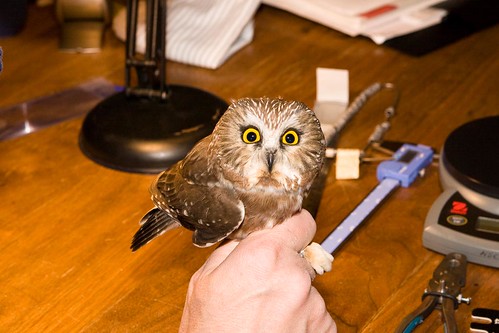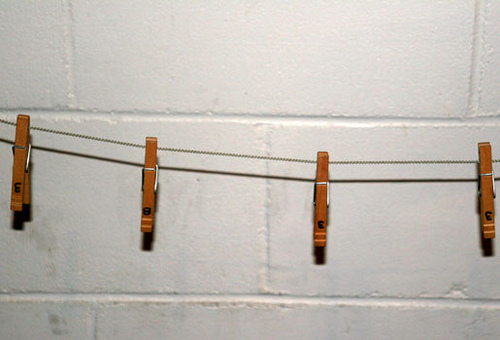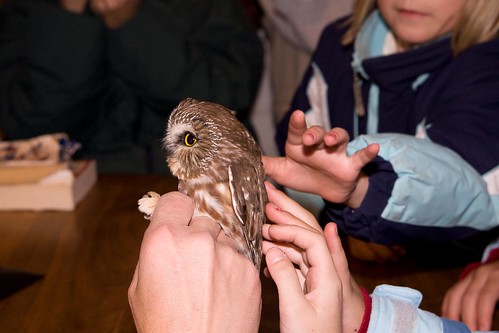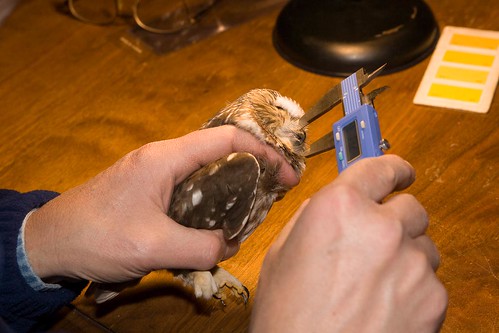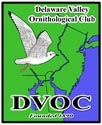Waiting for Godot’s Owls
November 8th - Saturday Night
We were waiting for owls. So far none had shown up. But it was only 2 hours after dusk and we were to give it 4 hours because that’s when the owls really get active. That’s what research biologists Nate and Denise told us. So we sat back and opened a couple of more beers and passed the home-made brownies around again. I was with about 15 other members of The Delaware Valley Ornithology Club (DVOC) up in Hidden Valley on one of the highlight field outings of the year—spending the evening with researchers on the Northern Saw-whet Owl Project. The Saw-whet Project is headed by Scott Weidansaul, an author and researcher who works with migratory birds. I wish I could say that the owl photos below were mine but in fact, all the images in this post (including the puzzle afterwards) were taken by Philadelphia bird photographer Jamie Stewart, who was kind enough to let me use them.
The Hidden Valley banding station is one of 3 located along the Pennsylvania Appalachians. The ridge alignment of these mountains, in particular Kittatinny Ridge, creates a corridor of favorable updrafts that comprise part of Atlantic Flyway. Nate was hoping for a low pressure system followed by a cold front because that would give the owls some umph to move south and improve the chance of a good capture rate that night.
From early October to the end of November many Saw-whets move south from Ontario and Northern New England. In winter months these owls may end up as far south as the Carolinas.
The banding station cabin was unheated and there were port-a-potties located conveniently just outside. It was a nice rustic change for me from the Philadelphia suburbs. In a corner of the room was the banding table with a heat lamp, banding equipment, and then a short clothes line set up between two chairs with clothes pins. Nate said that some nights when there is a surplus of owls caught in a the net at the same time the researchers put them in sacks, which keep the little guys gently contained and calm. The sacks are then suspended from the clothes line as they await their turn at the banding table.
This is one of my shots. It’s the only one on this post without an owl in it.
The body of a saw-whet owl is the size of a baseball and the head with feathers is not much bigger than a tennis ball. Take the feathers away, and the saw-whet skull barely weighs more than a ping-pong ball. Saw-whets are the smallest owl on the East Coast. Males, in general, weigh 75 grams while the females get up to a whopping 100 grams. Wee, fluffy, and unbelievably cute and cuddle-liscious, these owls attract dozens of banding volunteers who devote 2-3 evenings per week for 2 months on the project, as well as groups of visitors who want to see and learn something about these enchanting little owls.
Every 40 minutes or so Nate and Denise headed out to check the mist nets again hoping to get that haul of owls they had promised us. The weather was good, the audiolure was playing the sweet and, well…, alluring call of a male Saw-whet to stir the females to get out and about and hopefully into one of the nets. About 80% of the saw-whets that are caught throughout the state tend to be females. So far there is no completely satisfactory answer for that. The best theory is that the males with territories may hunker down to defend them as long as possible while females are freer to travel. Another thought is that perhaps the high capture rate of females reflects the actual demographics of Saw-whet owl populations.
In 15 minutes Nate and Denise return. Too soon. Not a good sign. We jeered as Nate assured us that the 3rd and 2nd to last net checks usually had the best results, and then we handed him and Denise more brownies.
To keep us from pounding the tables, chanting, “We want owls!”, Nate entertained us with more notes of interest about these birds. First of all, there are a lot more of them in PA than was previously thought, especially during migration. They are generally secretive and not as easy to spot as larger and more vocal owls, like the Great Horned or Barred. They are less active on nights with a full moon as their feared predators, Great Horned owls can spot them easier.
In fact, one banding stations had to be closed down as a result of predation. In the same way Coopers and Sharp-shinneds learn that backyard feeders are easy pickings, so Barred owls in that area discovered that this saw-whet banding station was a prime food spot. Silent and lethal, the Barred owls would follow behind the banders and snag the newly released saw-whets. “Sneaky” was how Nate described them.
Later in the evening we were joined by Scott Weidansaul and several board members of the Hawk Mountain Sanctuary, and it got livelier and warmer with the extra bodies in the cabin. Scott made his rounds greeting us in his friendly and engaging manner.
“Isn’t banding exciting?” He asked one little girl, the youngest member of the group, who had shown absolutely no signs of getting tired as the night went on. “You get to see all this wildlife.”
Everyone laughed because it’s true both ways; as this night attested, you don’t always get to see something, but on the otherhand, sometimes you will experience more than you could ever imagine. Owl or no owl, the being there is good, and whenever I do finally see a Saw-whet it will be that much better appreciated for it’s not having been so available.
Okay. One last net check. It was 11pm and almost time to call it a night and head home. Nate and Denise don their jackets and headlamps and head out again to check the nets. But soon they are back, empty-handed. Guess the owls had better things to do than fly into mist nets.
So. No owls showed up that night. But I got to hang out in a cabin in the woods with other people who love birds, and be a part of something good.
And then, there was an excellent bird joke told by our youngest member of the group:
Why don’t seagulls live by the bay?
Because then they would be bagels.
